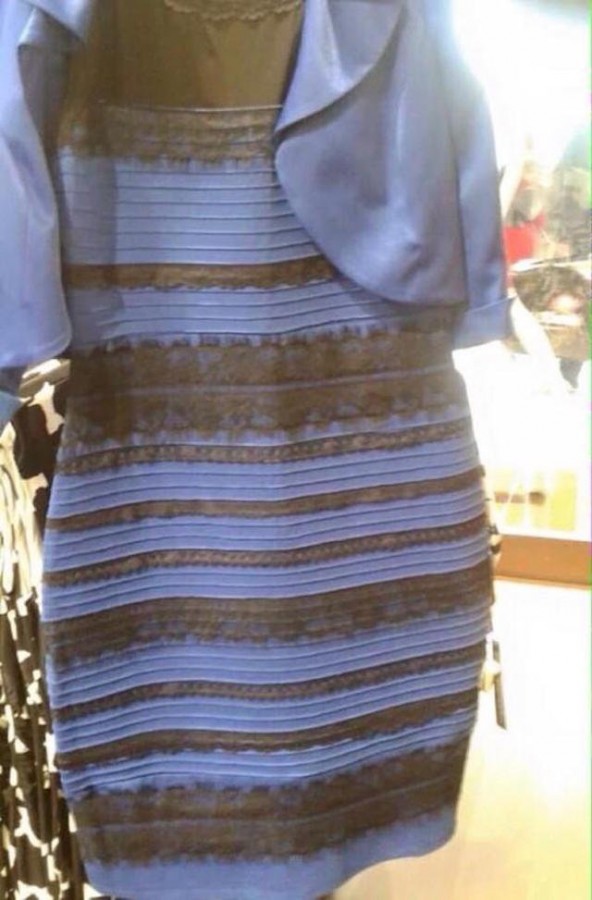Central psychology and sociology professors explain #thedress
March 12, 2015
It’s not an experiment or magic
On Feb. 25, tumblr user “swiked” posted a picture of what some saw as a blue and black dress.
Others saw it as white and gold.
The picture of the dress blew up on social media. By the following night, it had been reported on by multiple online news outlets, including Buzzfeed and Mashable. Even the New York Times, CNN, and a number of other established sites ran stories about the phenomenon.
As soon as the dress started to spread online, there were theories about why people were seeing it differently. Some thought it had to do with mood, others were convinced it depended on the amount of rods and cones that perceive color in our eyes. Several weeks later, scientists aren’t completely sure they have the answer.
But, they have a theory.
Dr. Ralf Greenwald, psychology professor and the director of the Brain Dynamics & Cognitive Neuroscience Lab at Central, said that color is simply a perception made by the brain when light hits the retina and is also influenced by the illumination the object is subjected to.

To compensate, the brain either adds or subtracts the illumination to perceive the true color of the object.
“There are also individual differences in how the brain performs this [process],” Greenwald said. “This is why some people interpret the blue color as shadow on a white dress which is in bright sunlight. Others discount the shadow and see blue and black, the true color.”
The fact that the picture of the dress was being viewed on different displays, such as phones or computers, also influences the illumination factor and is another reason why some viewers saw blue and black and some saw white and gold.
Psychology and sociology professors explain viewer reaction
While the internet doesn’t have the best track record for facilitating calm or rational discussion, the extreme online reaction to the dress can be attributed to more than just today’s frenzied online atmosphere.
Dr. Tracey Hoover, assistant professor for the sociology department, said that having our perceptions challenged can be alarming.

“We’re used to things like opinions beings different, but we aren’t used to seeing something different in terms of objects,” Hoover said. “There’s something called cognitive dissonance, when what you’re being told and what you’re seeing do not match, and it’s very disconcerting.”
For Hoover, the dress was gold and white, but her husband saw it as blue and black.
“[Hoover’s husband] was sitting there going ‘you’re crazy’ and he was getting kind of agitated,” Hoover said. “It’s difficult for us to understand, when it’s something we are used to being in agreement on, like something visual, when there are such extremely different perceptions, it doesn’t gel with our understanding of reality,” Hoover said.
Dr. Anthony Stahelski, psychology professor, said that for some people, accepting that their view of reality isn’t the only one, can be hard to swallow.
“My perceptions are mine uniquely,” Stahelski said. “I construct a unique subjective view of reality, and each one of us does that.”
People create their view of the world from the information that they take in and then translate in their brains, Stahelski said, but many people believe that their subjective view of the world is the way that everybody sees the world.
“Some people can more easily acknowledge that ‘it’s just me, it’s just the way that I see things,’ and you see things differently and that’s perfectly okay,” Stahelski said. “But then there are some people that really have difficulties letting go of the view that [their] way is the only way.”
For those people who can’t let go of their view, something like the dress- which has several different ways to perceive it- can cause an emotional reaction.
Stahelski said he believes that this difficulty in accepting other’s perceptions of the world isn’t just confined to optical illusions or internet memes, but is a major source of conflict between people, organizations, or even countries.
“It so hard for us to get out of our own selves,” Stahelski said. “That cliché phrase ’walk in somebody else’s shoes’ or ‘be empathetic,’ is a lot more difficult than just saying it.”


